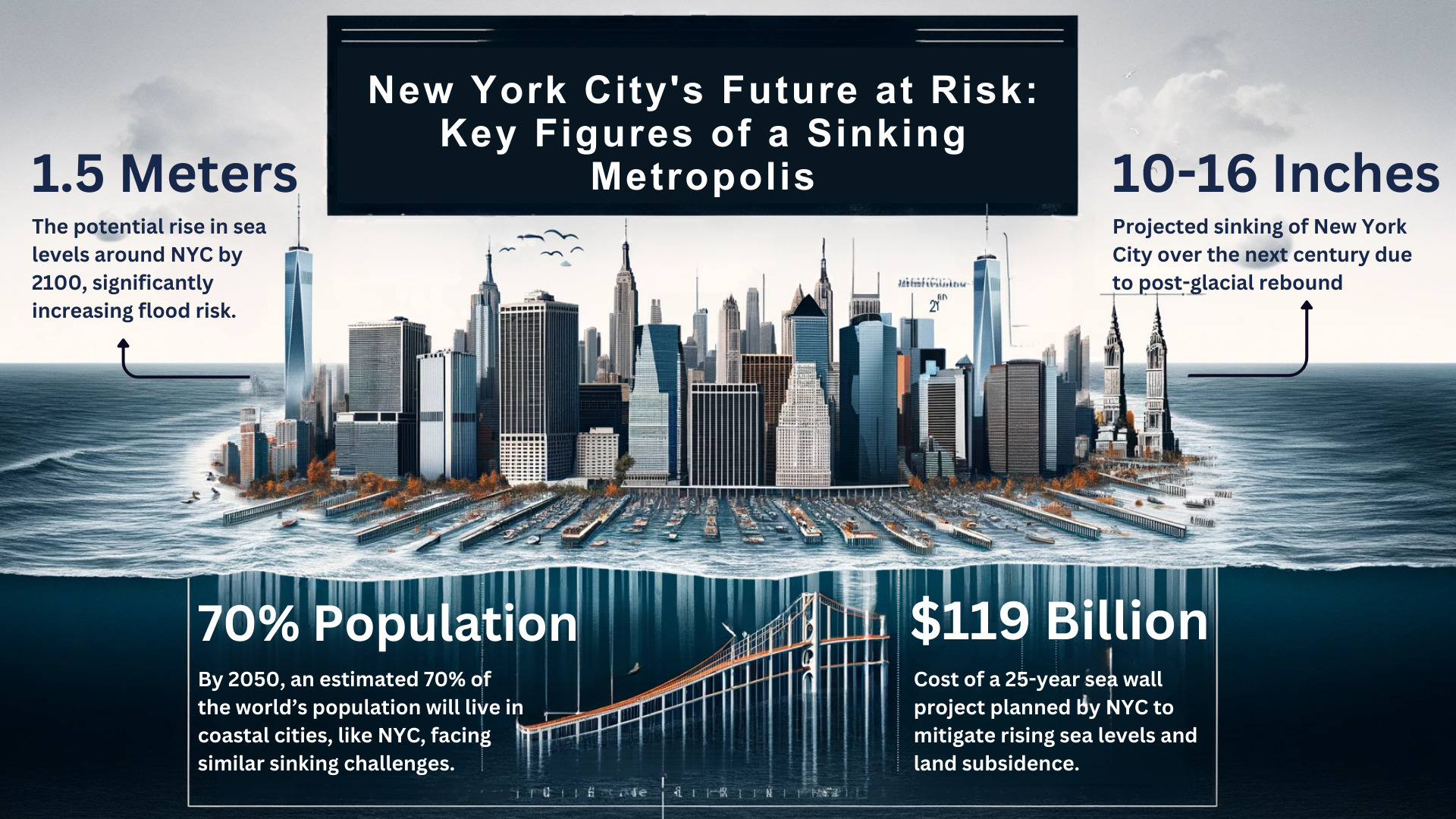New York City, one of the most iconic and populated cities in the world, is slowly but steadily sinking into the waters around it. A recent study by the U.S. Geological Survey found that by 2100, New York City could sink by as much as 1.5 meters due to rising seas and land subsidence. This has huge implications for the future of the city.
Why is New York City Sinking?
There are two main reasons New York City is sinking:
Post-Glacial Rebound
The first is post-glacial rebound. Around 18,000 years ago, during the last ice age, Canada and parts of the northern United States were covered in massive ice sheets over a mile thick. The weight of this ice caused the Earth’s surface to deform and sink. Now that the ice sheets have melted, the Earth is slowly rebounding back like a foam mattress.
This rebound is causing land across eastern Canada and the northern U.S. to rise while areas to the south, like New York City, sink. Models estimate parts of New York City could sink 10 to 16 inches over the next century due to this process alone.
Artificial Land Fill
The second factor is the artificial land fill New York City is built on. Much of NYC, including Battery Park, Roosevelt Island, and parts of the Financial District and Lower East Side, is built on land fill. This fill compacted and settled over time.
As the study author notes, satellite imagery reveals parts of NYC built on landfill are sinking at twice the rate of other areas. North Staten Island, parts of Queens near JFK Airport, and sections around Jamaica Bay are sinking rapidly thanks to settling artificial land.

What Are the Implications of a Sinking NYC?
New York City sinking has major implications for the future viability of the city:
Increased Flood Risk
First and foremost, a sinking New York City means increased flood risk, especially during major storm events. Hurricane Sandy provided a glimpse at how a relatively small amount of sea level rise can have catastrophic effects on NYC. With just 1 foot of higher sea level, Sandy’s flood waters were 2 feet higher than they would have been otherwise.
If New York City sinks 1.5 meters by 2100 as models predict, it would put nearly half the city underwater during high tide. Storm surges would reach even farther inland. Hundreds of billions of dollars in damage and loss of life could occur.
Challenges for Infrastructure
Secondly, a sinking city means huge challenges for infrastructure. The New York City subway system is mostly underground – but that underground changes depth as the city sinks. Steps, sewer pipes, water mains, and building foundations will all be affected.
Roads, bridges, rail lines, airports, and other infrastructure will also face drastically increasing challenges and maintenance costs as the land sinks and erodes around them.
Loss of Land Area
Finally, portions of New York City will simply disappear under the waves. Miles of harborside property and facilities will be flooded even at low tide. Useable land area will shrink, putting pressure on housing prices and development.
The New York City government is already planning a $119 billion, 25-year sea wall project to mitigate some of these effects. But if melting glaciers and post-glacial rebound causes acceleration of subsidence rates, the problem may outpace solutions.
Click here to learn more and subscribe to the newsletter
What Can Be Done to Save NYC?
New York City officials are taking actions to save the sinking city, but it may not be enough. Some of the efforts underway and options to consider include:
1) Replenishing Wetlands
Restoring lost wetlands around New York City can help act as a buffer against rising seas and storm surge. Wetlands also prevent erosion of land. Projects are already underway around Jamaica Bay and Brooklyn.
2) Raising Infrastructure
Utilities, subways, rail lines, and other infrastructure will need to be reinforced and elevated to adapt to rising sea levels as New York City sinks. This will require billions in spending.
3) Seawalls and Levees
Coastal infrastructure projects like sea walls, levees, floodgates, and removable barriers may hold back rising waters for a time. Projects like the Thames Barrier in London demonstrate such defenses can protect cities for decades when well-built and maintained.
4) Managed Retreat
If New York City subsides below sea level more rapidly than expected, managed retreat may become the only option. Critical infrastructure and populations may need to be relocated inland. But giving up America’s largest city without a fight seems unlikely.
5) Floating Infrastructure
Futuristic floating infrastructure projects have been proposed for other sinking coastal cities like Venice, Italy. New York may one day need floating roads and sidewalks, moored buildings, and other radical adaptations if aging seawalls fail to hold back the tide.
Get your free “2024 Real Estate Market Outlook” now!
Wider Implications Beyond NYC
New York City’s plight has wider implications for coastal regions worldwide. The United Nations estimates that by 2050, 70% of the world’s population will live in cities – and most of these cities are along the coast.
Jakarta, Indonesia provides a case study for the future troubles ahead. The city is sinking up to 6.7 inches per year due to excessive groundwater pumping. Coastal erosion has accelerated, and disastrous floods now regularly engulf regions of the city. Because mitigation efforts failed to stop the descent below sea level, Indonesia is planning to spend $40 billion relocating the capital to the island of Borneo.
While New York has more resources to combat land subsidence than Jakarta, all coastal metropolises from Tokyo to Miami to Shanghai should take note. The oceans are rising and the land is sinking fast. Only early mitigation efforts, massive spending on infrastructure upgrades, and advanced planning for retreat can prevent city-killing floods. New York City’s actions over the next decade may set the example for development of coastal regions around the globe.
Conclusion
New York City’s sinking predicament represents a canary in the coal mine for coastal cities worldwide. Post-glacial rebound and settling artificial land are causing the city to subside, and models estimate almost 1.5 meters of sinking is possible by 2100.
This land loss has catastrophic implications for flooding, infrastructure damage, housing shortages, and overall viability of New York City in its current form. Rising sea levels will only make these problems worse as climate change accelerates.
While New York plans ambitious sea walls and is restoring some wetlands, the extent of the problem may outstrip mitigation efforts. Other coastal mega-cities like Jakarta show managed retreat may eventually become the only option remaining.
How New York City handles its sinking landscape over the next few decades will set the tone for development of coastal cities globally. Trillions of dollars in infrastructure upgrades, relocation programs, and innovative adaptations will be required to prevent mass destruction of port cities via rising tidal floods made worse by sinking terrain.
The time for coastal cities to act is now – before sinking cities meet rising seas in a perfect storm of catastrophic proportions. The future viability of humanity’s great metropolises depends on bold ideas and unprecedented funding to elevate or float entire cities. New York’s actions serve as a model all sinking coastal cities must soon emulate.
Interested in multifamily real estate investing? Our experienced team is here to help. From market research to identifying the best opportunities, we guide you through the process. Subscribe to our YouTube channel for informative videos and expert discussions, and follow us on Instagram for exclusive content. Explore our comprehensive Udemy course for detailed insights and strategies. Ready to elevate your investment journey? Contact us now to schedule a consultation and achieve your financial goals in real estate.
*This content is for informational purposes only and is not intended as financial or legal advice. Please consult with a professional advisor before making any investment decisions.



























